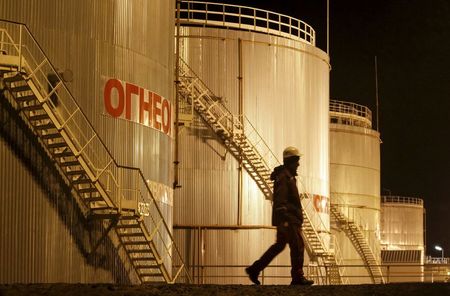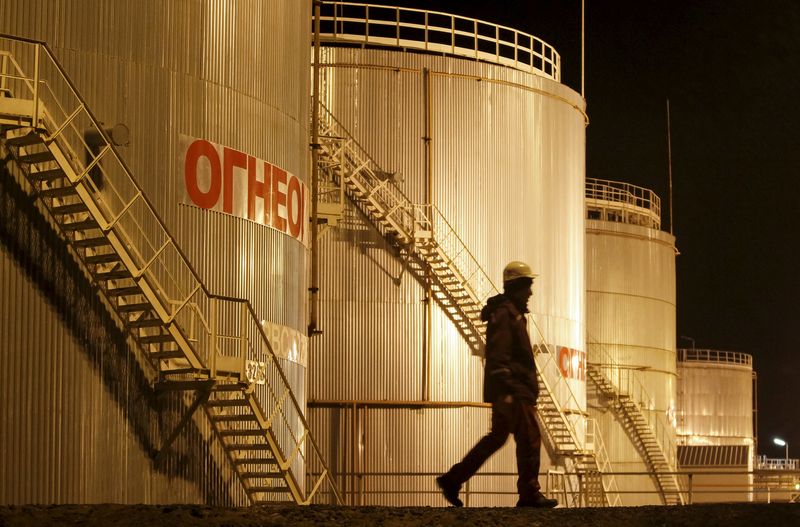Commodities
Oil prices inch lower as Fed, China fears dent outlook


© Reuters.
Investing.com– Oil prices fell slightly in Asian trade on Tuesday amid growing fears that higher-for-longer U.S. interest rates will weigh on demand, while renewed concerns over China’s economy also dented sentiment.
Strength in the put a damper on oil prices, as hawkish signals from the Federal Reserve saw the greenback scale a 10-month peak, pushing up crude costs for international buyers.
Markets also grew increasingly wary of more increases in U.S. rates, which are expected to weigh on economic activity this year and potentially hurt crude demand. The Fed had recently warned that higher energy costs, in the wake of surging oil prices, will likely buoy inflation and further the need for higher rates.
In addition to Fed-related headwinds, oil markets were also grappling with renewed fears of an economic slowdown in China, the world’s largest oil importer, as analysts soured further on its growth prospects this year.
The negative trends saw traders question whether oil prices had the capacity for more gains, especially after they surged to 10-month highs earlier in September.
fell slightly to $91.69 a barrel, while fell 0.1% to $89.58 a barrel by 21:04 ET (01:04 GMT).
China fears persist amid GDP downgrades, PMIs awaited
A string of major brokerages and investment banks- most recently S&P Global and HSBC- downgraded their outlook for Chinese economic growth this year, with analysts warning that gross domestic product could only grow 4.8% in 2023- lower than the government’s 5% forecast.
The downgrades come just a few days before key Chinese (PMI) data for September, which is expected to show continued weakness in business activity.
While PMI readings for August had shown some improvement in manufacturing activity, service sector growth declined through the month.
Fears of a meltdown in the China’s massive property market also came to fore this week after embattled developer China Evergrande Group (HK:) warned that it was unable to issue new debt.
While China’s oil imports have remained largely robust this year, the country’s appetite for fuel has struggled to reach pre-COVID levels. Beijing also set higher fuel export quotas for the year, indicating that local demand remained weak.
On the supply front, expectations of tighter fuel markets in the northern hemisphere were slightly dented after Russia said its planned fuel export ban will be somewhat less severe than initially expected.
But oil markets are still expected to tighten substantially this year, following deep production cuts in Saudi Arabia and Russia. U.S. rig counts were also seen dropping to a 1-½ year low last week, while recent data showed a consistent decline in .
JPMorgan analysts expect oil prices to trend between $90 and $100 in the coming year.
Commodities
Oil prices rise; U.S. crude inventories plunge, Russia-Ukraine truce eyed
Commodities
India’s Reliance to stop buying Venezuelan oil over US tariffs, sources say
Commodities
Oil prices climb on Venezuela supply worries

 Forex3 years ago
Forex3 years agoForex Today: the dollar is gaining strength amid gloomy sentiment at the start of the Fed’s week

 Forex3 years ago
Forex3 years agoUnbiased review of Pocket Option broker

 Forex3 years ago
Forex3 years agoDollar to pound sterling exchange rate today: Pound plummeted to its lowest since 1985

 Forex3 years ago
Forex3 years agoHow is the Australian dollar doing today?

 Cryptocurrency3 years ago
Cryptocurrency3 years agoWhat happened in the crypto market – current events today

 World3 years ago
World3 years agoWhy are modern video games an art form?

 Commodities3 years ago
Commodities3 years agoCopper continues to fall in price on expectations of lower demand in China

 Economy3 years ago
Economy3 years agoCrude oil tankers double in price due to EU anti-Russian sanctions



































